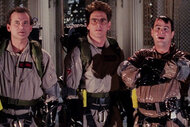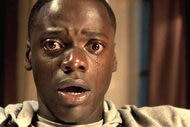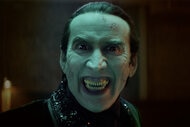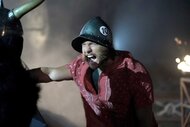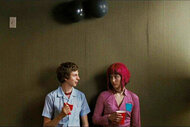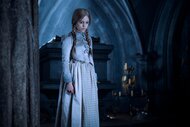Create a free profile to get unlimited access to exclusive videos, sweepstakes, and more!
How Dark utilizes yellow costumes as a symbol of love and a sign of danger

Color language has more than one meaning, which genre utilizes to disarm and challenge preconceived notions. Red is a siren call that can mean danger, death, or desire — sometimes a combination of all three — drawing all eyes to the wearer of this shade. But, sunny in disposition, the color yellow can also signify a visual warning while also playing the romance costume card.
In the recent horror-comedy Little Monsters, Miss Caroline's (Lupita Nyong'o) kindergarten appropriate frock is left blood splattered to underscore the absurdity of this zombie scenario. A bright shade plays a sinister role in the recent Watchmen limited series putting a new spin on the signature shade of the graphic novel. It is also steeped in the sickly fear of nuclear and biohazard materials depicted via protective equipment that is a universal code to suggest something terrible has happened. Pantone refers to this instantly recognizable shade as "Safety Yellow," which is something the characters on Dark require.
Netflix's time-travel German series is a mind-bending experience thanks to its combination of quantum physics, existentialism, and melodrama. Meticulous in its execution, it will leave you scratching your head and reaching for your remote to see how early they planted clues. Significant costume moments play a big role in establishing connections and underscoring narrative themes.
Dark spoilers ahead.
From the first episode, Anette Guther's costume design uses a bright shade of yellow as an anchor. Jonas' slick mac is a bolder tone against a muted backdrop — even in the early episodes, it feels like the color has been drained out of the Winden location. An image repeated throughout Dark's promotional materials, one's eye is immediately drawn to this garment and implied connection to the lead character.
Hard to date, a raincoat in this style benefits from its timeless and gender-neutral aesthetic. Fads and trends will create unnecessary attention to a person traveling from the future — see Marty McFly's "life preserver" fashion statement in Back to the Future — but Guther typically chooses garments that won't look too out of place 33 years in the past. Considering how much it rains in this town, a raincoat is a must-have item and the youthful quality of Jonas' outerwear underscores his innocence before he gets caught up in the knot.
Horror fans will associate this garment with Georgie's horrifying fate in It, which feeds into the juxtaposition of a violent act against such a cheerful garment. However, the history of how this color is used denotes the duality that comes from its hard to ignore status.
A smiley face and the symbol for nuclear radiation are at the opposite ends of the same color spectrum. One was created for an insurance company logo in 1963 and has since expanded into a multi-million dollar business (with a messy copyright/trademark backstory) representing positivity — that Watchmen later twisted into a blood-stained symbol. Meanwhile, the radiation warning known as the nuclear trefoil was first conceived in 1946. The recognizable design "was supposed to represent activity radiating from an atom," although the yellow and black color coding wasn't standardized until 1948. We bring up these two symbols because they establish how this color has been adopted by contrasting logos — the latter is directly referenced in Dark as a result of the significant nuclear power plant location. Advertised as "an important investment" this image of Cold War ego is the epicenter of the action in Winden.
Dark uses this color as a nuclear warning, a symbol of youth, a tether to another world, and a romantic symbol. Nature is awash with this shade but manmade atomic power emphasizes the unnatural element that puts the residents in danger. Juggling themes within the narrative extend to the costume and production design, which makes it such a satisfying (and mind-boggling) watching experience. It is also a potent and memorable image, so when Martha (Lisa Vicari) from the alternate world wears this jacket it suggests she is taking on the Jonas role in a world in which he doesn't exist.
Trading his yellow slicker for a dirty yellow hazmat suit in the future, Jonas is probably sick of wearing this signature color. When he returns as the middle Jonas (not to be confused with the band) all traces of primary shades have been removed from his closet. After all, bright yellow isn't the best skulking attire — neutrals are far better for the hanging out in woods.
In Season 2, teen Jonas still favors a dash of yolk with the now timely face mask that appears on the key art and as he stomps through the desolate and poisoned Winden landscape. A symbol of something unnatural, the mask element ties to the hazmat suits that remain in the shell of the nuclear plant.
The suits themselves are a harbinger of what is to come, which appear in their shiny glory in the scenes set in 2019. Eerily hanging from the wall in a variety of sizes — as if they are about to come to life at any moment — the protective equipment cannot prevent or shield them from the apocalypse. When Jonas rocks up to the plant in 2052, only two suits remain and they are far from their former clean state. A sunny aesthetic holds a level of promise or at least in the case of the suits a level of protection, however, the more muted version is the consequence of time spent in this toxic energy source.
Stopping a future that has already been written is the paradox at the heart of Dark, untangling a rope with no end is a seemingly impossible task. Red represents this knot, making its mark on the night Mikkel (Daan Lennard Liebrenz) disappears, traveling back to 1986. His coat is this shade, matching Martha's red scarf that points to a link to Ariadne's thread weaving its way through the story — this show benefits from a rewatch. Earlier that summer, adult Mikkel (who is now going by Michael) tells his son Jonas that it is likely to storm. An innocuous remark, but one that sees Jonas grab the raincoat that will allow the Jonas from the future to masquerade as him — Martha somehow doesn't find his spontaneous longer hair and haunted expression alarming.
Not every character sticks to a neutral palette and, notably, Claudia Tiedemann (Julika Jenkins) and Agnes Nielsen (Antje Traue) have closets stuffed full of the trends from the '80s and '50s. Claudia's is to reflect her boss lady status before she gets entangled in the time travel of it all. Meanwhile, Agnes plays a mysterious stranger whose brief time in mid-century Winden causes an intense sexual awakening in Claudia's mother.
Arriving in 1953, Agnes stands out in a glamorous boat neck red skirt suit. Renting a room at the Tiedemann home she instantly makes a connection with lonely housewife Doris (Luise Heyer). Bonding over her fabulous frocks, fashion isn't the only thing Agnes opens her world up to. Trying on a yellow dress in "Everything Is Now," Doris remarks "I feel like the Queen of England has invited me to tea." Telling her she is beautiful, Doris blushes at the unfamiliar attention.
In Season 2, Claudia walks in on her mother on the receiving end of pleasure her husband has never given her. Agnes is once again impeccably dressed, this time in a yellow halter neck tailored top and matching skirt; she is movie star-ready. Rather than the red of her arrival, it is more potent to chart Doris' sexual awakening through the color yellow suggesting a starry-eyed state. Leaving the comfort of this tryst, Agnes' role within the wider time-traveling scheme is revealed when she ventures into the secret bunker. Pairing the canary ensemble with a black hat, gloves, and heels makes her look like the nuclear trefoil come to life on the pages of Vogue. Meeting the older Claudia, she is told that she could make Doris happy if she chose to stay. Sadly for her new lover, she opts for the wider cause and leaves this yellow outfit as a reminder.
Notable yellow costumes are often steeped in romance whether it is Belle's Beauty and the Beast ballgown or iconic images from rom-coms like How to Lose a Guy in 10 Days. Choosing this shade to signify the love story between Doris and Agnes plays into this costume motif.
Even Jonas and Martha's unconventional — alt Martha isn't related to Jonas — pairing shares a canary yellow tether. But as with the bird that gets sent down the coal mine, this raincoat is not a symbol of good fortune. Instead, it is a link to the past, present, and future across the different worlds, which even stands the test of time and quantum physics in the series finale. Whether to keep dry, avoid radiation sickness, or an expression of love, three seasons of Dark has been lit up by this choice of color attire.








